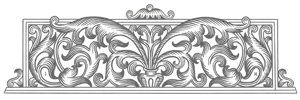CANADA COURIER by Christopher Guly
Ottawa gets another church - in a museum
Usually, when something ends up in a museum, it becomes a relic to the past. St. Onuphrius Ukrainian Catholic Church, which made an over 3,500-kilometer or 2,200-mile journey from Smoky Lake, Alberta, to the Canadian Museum of Civilization in Hull (across the river from Ottawa), is clearly the exception.
After crossing eparchial boundaries (from Edmonton's jurisdiction to Toronto's), St. Onuphrius Church will be open for worship. "We're hoping to work closely with parishioners at St. John the Baptist [Ukrainian Catholic] Church to perhaps have special celebrations at Christmas and Easter," said Steve Prystupa, the museum's prairie historian who is also the curator, not pastor, of the St. Onuphrius Church exhibit.
When the reconstructed church was officially opened on June 26 - the Feast Day of St. Onuphrius according to the Julian calendar - there was much liturgical celebration.
Ukrainian Catholic Archbishop-Metropolitan Michael Bzdel of Winnipeg conducted a moleben prayer service, following a procession from the museum's Grand Hall to the Canada Hall, where the church is situated.
Since the church was consecrated 81 years ago by Canada's first Ukrainian Catholic bishop, Nicetas Budka, blessing it again was unnecessary.
Two couples, marking their 50th and 60th wedding anniversaries - and former parishioners of St. Onuphrius Church from its former Alberta home - also had their wedding vows renewed during the ceremony.
"My grandfather helped put the dome on St. Onuphrius Church," said Ed Pohranychny, one of about 40 former parishioners who traveled by air to attend the event. "My parents were married there. I was baptized there. So were my brothers and sisters. This church was an important part of our lives."
Now, it will become an important part of the Canadian Museum of Civilization.
Indeed, St. Onuphrius Church is, so far, the most authentic artifact in the Canada Hall and part of the permanent exhibition's reflection of life in western and northern Canada between 1885 and the present.
Plans are under way to add the facades from an ethnic music store and Mennonite printing press near the church by 1998.
Getting St. Onuphrius Church to Hull, however, was an effort in itself.
Closed in 1965, it sat dormant for 30 years in Smoky Lake - about 70 miles or 113 kilometers northeast of Edmonton - until the museum acquired it last year as a donation from its congregation. (The parishioners moved to a new church a few miles away.)
"We surveyed close to 25 churches across the Prairies before finally deciding on St. Onuphrius," said Mr. Prystupa. Several factors were considered during the selection, including its geographical position (coming from Alberta, the province with the highest concentration of Ukrainian Canadians); its size (12 meters by seven metres and only nine metres high - or 39 x 23 x 30 feet) - in order to squeeze into the gallery space - and its architect, the Rev. Philip Ruh. St. Onuphrius was the first of more than 30 churches the French-born Oblate priest built on the Canadian prairies.
It was either named after the fourth century Egyptian monk, St. Onuphrius, or one of the church's founders, Onufry Kulchinsky. The Smoky Lake church was built first as a chapel in 1907; eight years later it was constructed in its current form.
At a cost of $500,000 (about $373,000 in U.S. dollars), the museum disassembled and then reassembled it to its original form. Experts in church architecture and Ukrainian Canadian settlement were enlisted to help with the nearly nine-month-long project.
Three-dimensional computer drawings, using measurements taken by lasers, were taken of the church prior to its cross-Canadian journey. When it arrived at the museum last September, St. Onuphrius was in pieces contained in marked crates.
Now, it appears as if time, and geography, stood still. The iconastasis, carved by Ukrainian Canadian Harry Holowaychyk and painted by Edmonton artist Leo Snaychuk, is there - as is the church's interior, painted by Ivan Keywan in 1952.
About 70 people can cram into the church's limited pew space. Mr. Prystupa, former curator of multicultural studies at the Museum of Man and Nature in Winnipeg, expects some people may request to use St. Onuphrius for weddings or baptisms. But he said the museum has not decided how to handle such queries.
However, the Rev. Peter Galadza, who teaches Byzantine worship at the Metropolitan Andrey Sheptytsky Institute for Eastern Christian Studies at St. Paul University in Ottawa, says he would be interested in holding regular liturgies at Ottawa's second Ukrainian Catholic church.
"If I had a group of interested people, as long as I did not offend anyone at St. John the Baptist Church, sure I would do it," he said.
Should the museum one day decide it no longer wanted the edifice, the Rev. Galadza said he would be only too willing to take it off their hands. "I know just where I would put it. There's a beautiful patch of greenery between the two university buildings on the St. Paul campus," he said.
Copyright © The Ukrainian Weekly, August 25, 1996, No. 34, Vol. LXIV
![]() Download this article as a PDF (62kb)
Download this article as a PDF (62kb)
Christopher Guly, "Ottawa Gets Another Church – in a Museum," The Ukrainian Weekly, August 25, 1996.

